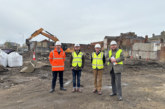Tackling climate change through retrofitting London’s housing stock. Joanne Drew, Director of Housing and Regeneration at the London Borough of Enfield and Darren Welsh, Deputy Strategic Director – Resident Services at the London Borough of Waltham Forest, talk to LABM about the Retrofit London Housing Action Plan and the need to ensure the market ecosystem surrounding retrofit is robust.
The threat posed by climate change requires all levels of government to act quickly and ambitiously if we’re to avoid its worst effects. Across London, local authorities recognise the scale of the challenge and are taking forward plans to address it. To date, 28 boroughs have declared a climate emergency and in December 2019 all 33 local authorities in the capital signed up to the London Councils Joint Statement on Climate Change. This outlined a series of pledges to achieve significant reductions in carbon emissions across London.
The new Retrofit London Housing Action Plan sets out a path to achieving the first of these pledges: upgrading all housing stock to an average Energy Performance Certificate rating of B by 2030. The entire action plan can be found on the London Councils website. This target is further to the longer-term statutory requirement set out by the Government to achieve net zero carbon emissions by 2050.
Delivering a programme of mass retrofitting across London is vital if we are to combat climate change. Homes make up around one third (36%) of London’s total greenhouse gas emissions. The action plan is a significant contribution to London’s aspirations and statutory requirements to reach the net zero target. Retrofitting London’s 3.8 million domestic buildings is a huge task, but with recent polling showing that the overwhelming majority of Londoners (82%) are concerned about climate change, we know our residents are ready to play their part.
Retrofit action plan
The plan was developed by London Councils and the London Housing Directors’ Group, with support from the London Environment Directors’ Network, the GLA, and Enfield and Waltham Forest as lead boroughs for this project.
It not only sets out a series of eight shared principles for taking forward home retrofitting in London, but also detailed actions that can help boroughs collaborate on this shared challenge.
The eight key principles are:
-
- Boroughs need to retrofit their own stock and facilitate retrofit on the whole housing stock.
- Boroughs are vital in creating and shaping a stable and sustainable retrofit market.
- Planning decisions and guidance should support low carbon retrofit.
- We need to move away from gas heating rapidly (and hydrogen is unlikely to be the answer).
- Achieving net zero will require energy efficiency and carbon data/metrics in addition to EPC ratings.
- Retrofit should seek to avoid a significant increase in energy costs.
- Asset management/maintenance decisions should be consistent with the Retrofit Action Plan.
- Boroughs will work collectively to develop skills, procurement models, and engage with residents.
Further to these broad principles, the action plan sets out decisive steps for addressing the details of the retrofit challenge. While boroughs will differ in their strategy, a common overarching goal and set of collaborative actions can support councils to go further, faster and more efficiently. The plan covers activity across wide ranging areas, from technical matters and delivery mechanisms, through to communications and engagement.

Analysis and approach
On technical features, it includes detail on electrifying heating, increasing solar generation, and improving the building fabric of London’s homes, amongst other innovative technological solutions. The action plan also adopts an ‘archetype by solution’ approach, with aspirations to develop whole-house retrofit templates for properties based on the solutions required for common housing types.
Analysis undertaken to support the action plan found that just 14 common housing typologies accounted for almost 94% of London’s housing stock, providing a more manageable approach to what can seem a daunting challenge. By looking at common measures for certain building types and areas, effective retrofitting can be rolled out across London at scale.
An area-based approach will also be important, with different providers — particularly councils and housing associations — working together to efficiently retrofit across multi-tenure sites.
Ensuring the market ecosystem surrounding retrofit is robust means developing retrofit skills actively across London and giving certainty to supply chains, helping to ensure materials and services can be procured at scale.
Early engagement with social tenants, owner occupiers, and landlords can help bring the public on side with the disruptive elements of retrofitting, while communicating the longer-term benefits that will be generated is important.
Finally, a fully funded action plan will need us to maximise capital finance for council-owned stock as well as support the owner occupier and private rented sectors to leverage private investment — facilitated by a ‘finance for retrofit’ taskforce involving financial experts.

Costs and funding
All of this is achievable if boroughs and partners are properly supported. Modelling suggests that reaching net zero will cost £98bn across all 3.8 million homes in London.
To achieve this, we need further support from government to help landlords and private homeowners bridge the cost of home retrofit and incentivise action. But increased government assistance for councils is also essential. Boroughs have already been asked to do more with fewer resources, with Housing Revenue Account budgets under pressure from previous rent cut policies and the impact of Covid-19, as well as requirements in relation to building remediation, new-build and forthcoming Decent Homes Standard revisions.
Given that boroughs will be leading on retrofit, not just for their own stock but enabling retrofit locally, the Government must provide consistent funding that can be used flexibly to address local challenges, as well as provide the necessary policy levers to help meet these shared goals. Having a holistic and long-term approach will support the development of a world leading retrofit sector in the UK, which can level up the fuel poor and spark a green skills boom; based on Retrofit London forecasts, at least 110,000 additional jobs could be created in London alone by 2030.
Going forward, this action plan and the forthcoming implementation plan will be key in embedding retrofitting as a central activity for all asset management and housing management teams. By engaging with the retrofit agenda now, we can integrate retrofit into everything from building safety works to home repairs going forward, accelerating London’s progress towards net zero.
Header image shows the installation of 12 photovoltaic solar panels at London Borough of Waltham Forest’s demonstrator project — 47 Greenleaf Road, Walthamstow.









